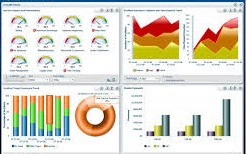Dashboard or Wallpaper, what's the difference? The
easiest way to describe it is that a Dashboard is exactly that, a clear and
concise representation of actual Business Performance compared to specified
Targets and Ranges, much in the way a Car's Dashboard shows you the key
operational functions in a single glance. As with the Car's Dashboard, you don't
want to be distracted by functions that are operating in the accepted ranges,
but have brought to your attention those that are reaching critical Levels. |

|